
Many businesses and organizations are using automation in the workplace. These processes can take over time-consuming tasks and improve everyday business operations.
Automation empowers business leaders to identify inefficiencies and create more robust methods for team members to work more efficiently. Leveraging these strategies can enhance customer and employee experiences, aiding business growth.
Keep reading to discover how you can leverage automation to streamline processes, minimize errors, boost the customer experience, and more.
Workflow automation can make time-consuming tasks, such as progress tracking or data entry, much simpler and quicker. These processes can minimize errors and save time so your team can dedicate their efforts toward more meaningful actions.
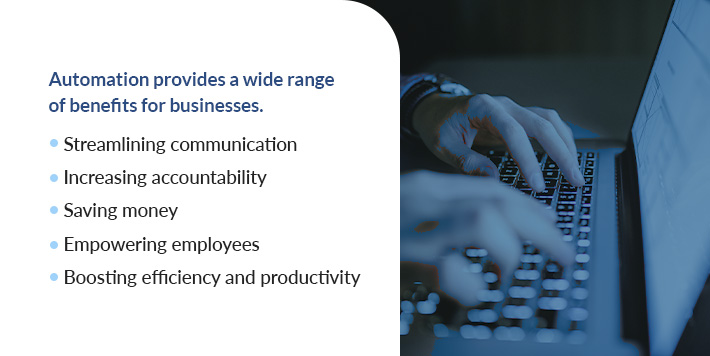
Automation provides a wide range of benefits for businesses.
There are many ways to utilize automation to your advantage. Your business goals and needs will impact which processes will be most beneficial for your team. Automated businesses can leverage various tools to improve workflow and enhance the customer experience.
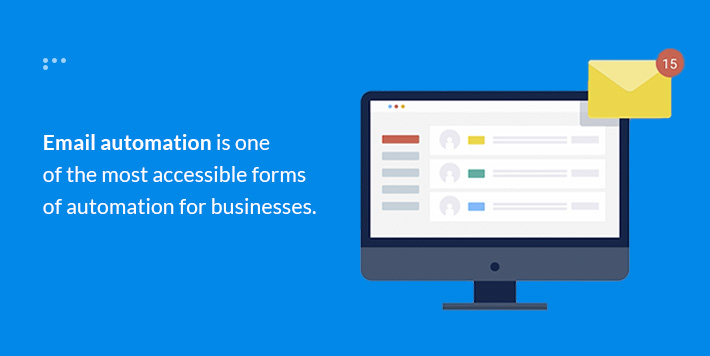
Email automation is one of the most accessible forms of automation for businesses. This type of automation allows you to establish a set of rules, permitting you to send specific emails at precise times. Email automation opens gateways for new opportunities for customer interaction by cutting through competition and speaking directly to potential customers.
You can accomplish a variety of tasks using this strategy, such as:
Posting on social media can be a time-consuming task, especially if you want to get something out quickly. A social media scheduling tool can automate this process and save time for busy marketing teams.

These tools allow you to create content in advance and schedule a time for it to post so you can continue delivering fresh information with peace of mind. You can automatically upload content to your key platforms, from blog posts to daily announcements to promotional information about new products, services, or launches.
Responding to customer service requests is vital for keeping happy customers and showcasing your organization as one that cares about its audience. Response time is a crucial metric for driving customer satisfaction, but it can be challenging for teams to meet demands while carrying out manual customer service.
Automated service request responses can provide notifications detailing when to reach out to each customer. This process allows you to practice targeted outreach and reach better results. You can also use satisfaction surveys to alert your team to a customer needing quick attention.
You can also use chatbots to answer simple or common questions. For example, you can train the AI tool to provide information about the returns process or route a customer to the best representative for assistance regarding their concerns.
However you leverage automated responses, you can empower your team to manage a high volume of customers effectively while embracing one-on-one interactions.
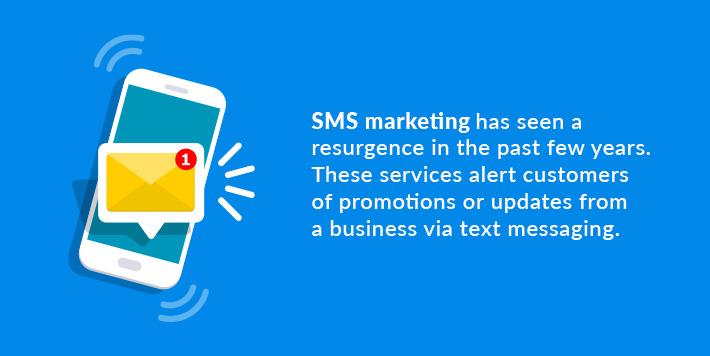
SMS marketing has seen a resurgence in the past few years. These services alert customers of promotions or updates from a business via text messaging.
Customers can opt-in for SMS messaging and receive short snippets of content directly to their message inboxes. This strategy empowers organizations to contact customers at the right time. For example, you may send more frequent messages to someone who makes regular purchases while only sending quarterly messages to someone who buys around the holidays.
You can use SMS to:
One of the most significant benefits of using automated processes is reducing the time your team spends completing repetitive tasks. Tasks like saving files in specific folders, sorting emails, creating data reports, entering data into spreadsheets, or posting a status update every time you upload a new blog can quickly consume time. Automating these repetitive processes can help you minimize mistakes and encourage your team to complete more meaningful tasks.
You can also use automation tools to outsource specific tasks to experts or trained team members to increase productivity and efficiency. Delegating tasks to specialized departments or individuals can give your organization an authoritative boost among competitors and ensure you deliver the highest possible quality content.
Task management systems are tools that empower organizations to complete projects efficiently by prioritizing tasks in a central location. While pen-and-paper methods can serve as momentary reminders, a task management system can minimize errors and organize information to help your team complete tasks timely.
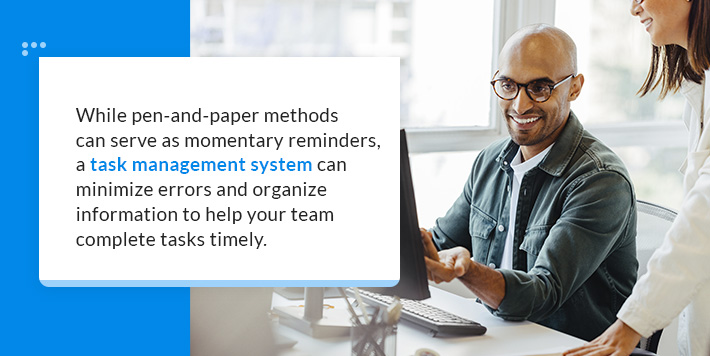
These tools provide a central location for team members to identify their next tasks. Individuals can monitor upcoming work and due dates, eliminating the need for reminders and empowering you to track progress to support them if they need help.
Task boards can ensure your team completes time-sensitive items first and create a cohesive workflow. This process can reduce the time your team may otherwise spend trying to determine what step to complete next. Additionally, these systems can help your team visualize the entire project, allowing the project to become more transparent and boosting collaboration.
You can streamline essential communication with automation. This strategy can support your team’s growth and clarify interactions. For example, you can use automation to:
Enhancing internal communication can also make project completion more efficient. If your team often balances multiple projects at one time, it can be challenging to remember every detail necessary. Your automated processes can provide your team with the support they need to finish objectives promptly and collaborate with other team members to achieve the best possible outcome.
Onboarding new hires often features many repetitive tasks. You can automate the onboarding process by generating compliance and legal forms for new hires to sign electronically. This process can reduce waste by eliminating physical papers and ensuring each new hire receives and provides the same starting information. You can also sync data across your systems to reduce manual errors.
Other tasks you can automate for the onboarding process include:

It can be frustrating to send emails back and forth to determine the best meeting time, especially if a time-sensitive task needs attention. Optimize the scheduling process by using a scheduling tool to sync with your calendar. You can integrate these tools with your CRM, ensuring your contact list can always access an accurate report of your latest interactions.
This strategy allows contacts to see your availability and schedule a meeting time with you without needing to wait for email replies, which can be helpful for your team, new hires, and potential business partners. You can create a form or attach a link for anyone to view available meeting times, ensuring you can capitalize on every possible opportunity.
You could benefit from a password manager if your team uses various websites and software to run your business. These tools make sharing login information easy while protecting sensitive data. A recent study highlights that more than 90% of respondents use the same password for multiple sites. Additionally, many people rely on personal information — such as family names, pet names, or hobbies — to create a password.

By leveraging a password manager, you can ensure your team uses strong passwords that feature a combination of letters, numbers, capitalization, and special characters that are much more secure. Additionally, you can boost productivity by creating a central location for accessing these passwords.
Many organizations have increased their use of artificial intelligence and machine learning tools. AI can streamline reporting processes and data entry and even help creative teams with content creation, outlining, researching, or editing. There are many ways to leverage these tools to boost team productivity and enhance the customer experience.
Automated processes can make it easy to send information or empower team members to access information when they need it. Creating a central location for essential documents and automating the sharing process can ensure your team can access information quickly so they can continue working on tasks.
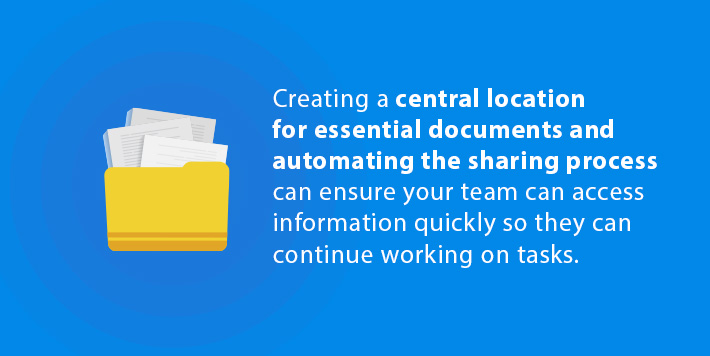
Some automated tools can also automatically retrieve data sets from unique fields in documents. This process makes sharing vital information with team members easy while increasing communication. These tools can save time and ensure your team minimizes compliance issues or errors that could result from misreading or forgetting essential information.
Automation can also aid in risk management. Risk mitigation is essential for every organization, and the slightest error can have costly consequences for many businesses. Automating risk management processes can reduce errors and ensure your team maintains compliance.
AI-powered tools can analyze patterns to identify anomalies and capture potential cyberattacks. These automated processes can work much faster than human workers and identify threats with more accuracy. Leveraging these tools can also protect sensitive business and customer information.

Automation can transform your business by enhancing customer experiences, reducing costs, and adding protection. When you want to automate your process, rely on us to deliver customized solutions. Salient Process provides the systems you need to optimize your business and achieve more profitable outcomes while saving time.
Adapt automation to fit your business’s needs and goals with Salient Process. Connect with our team to learn more about our advanced solutions and how we can help your business.